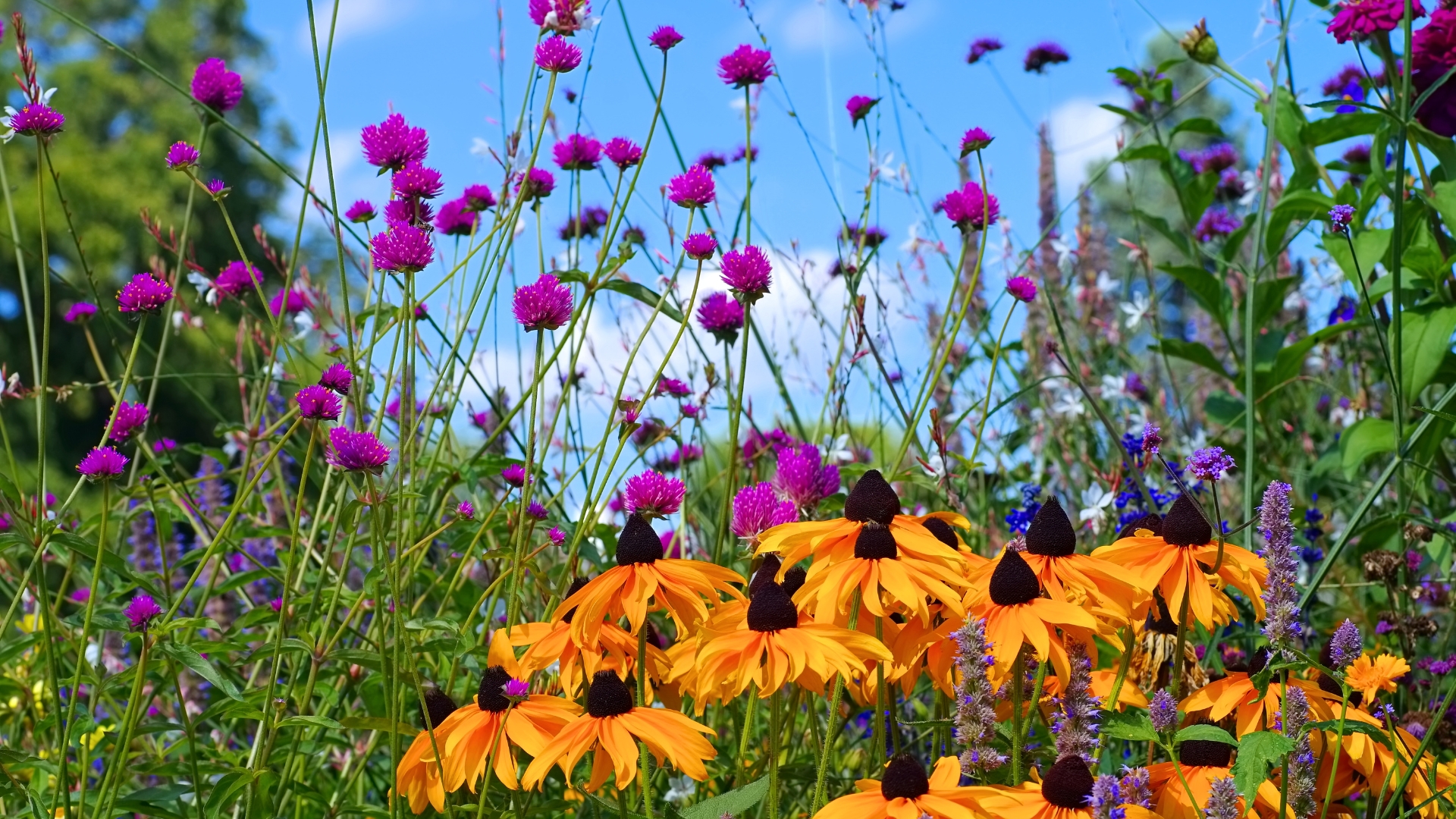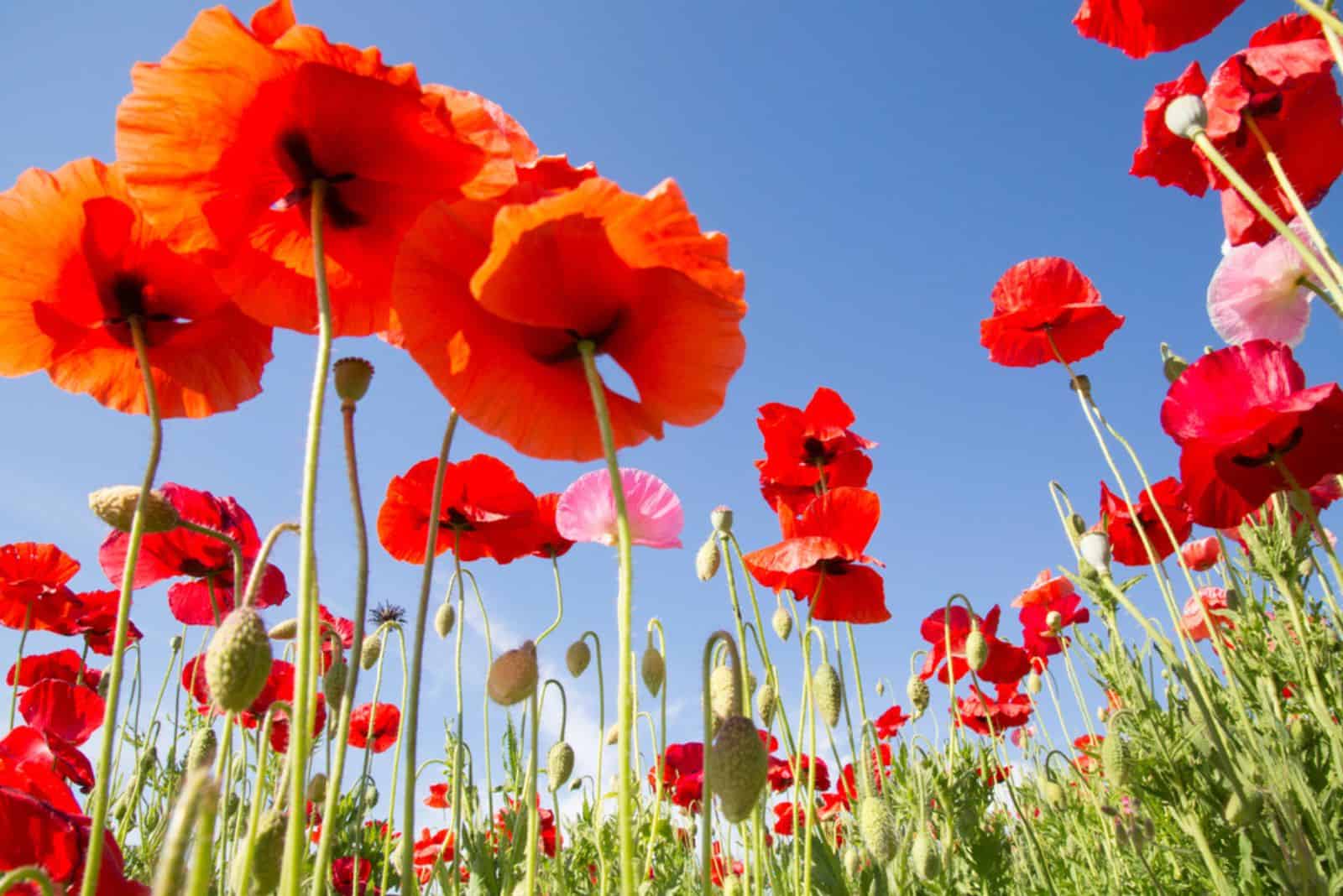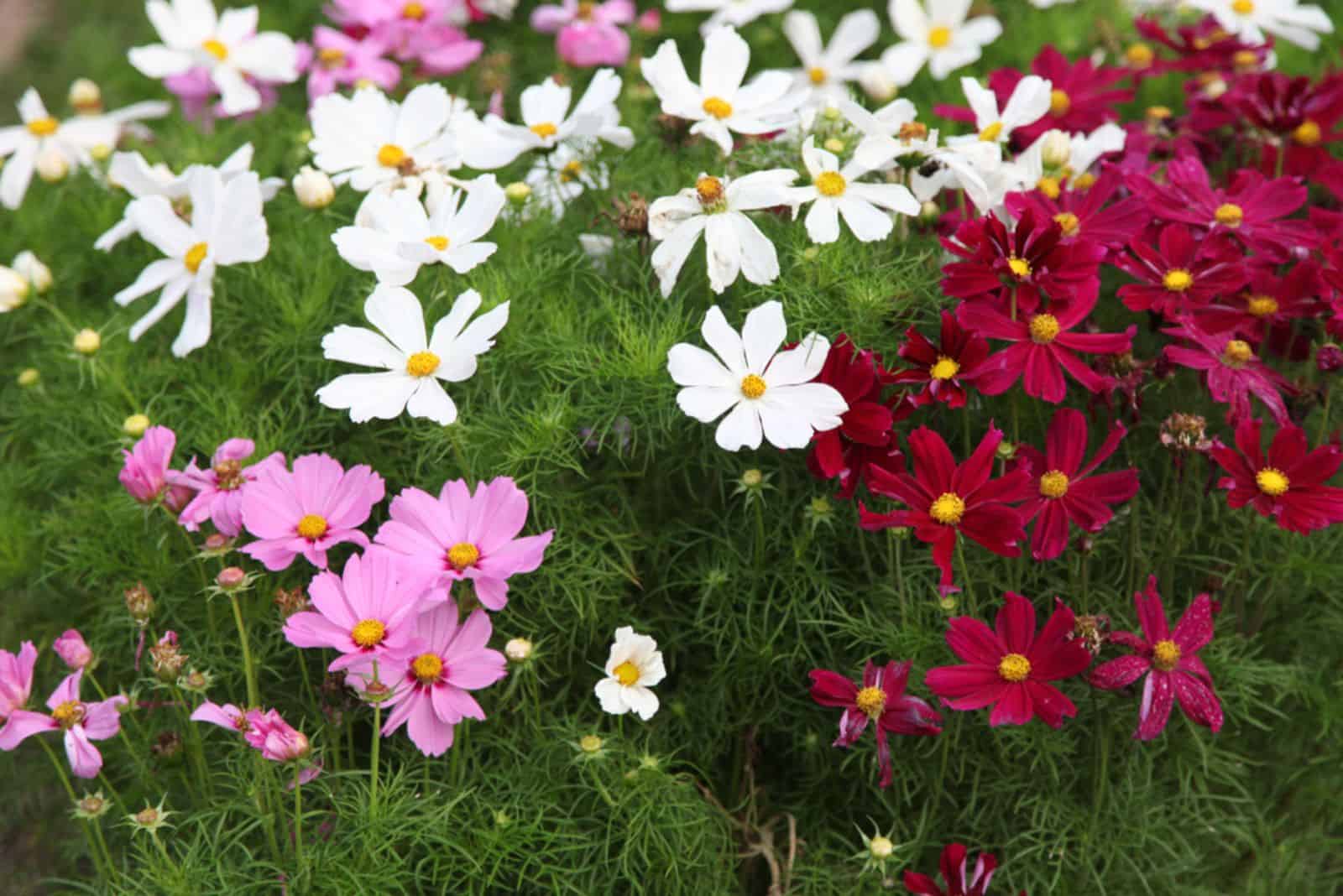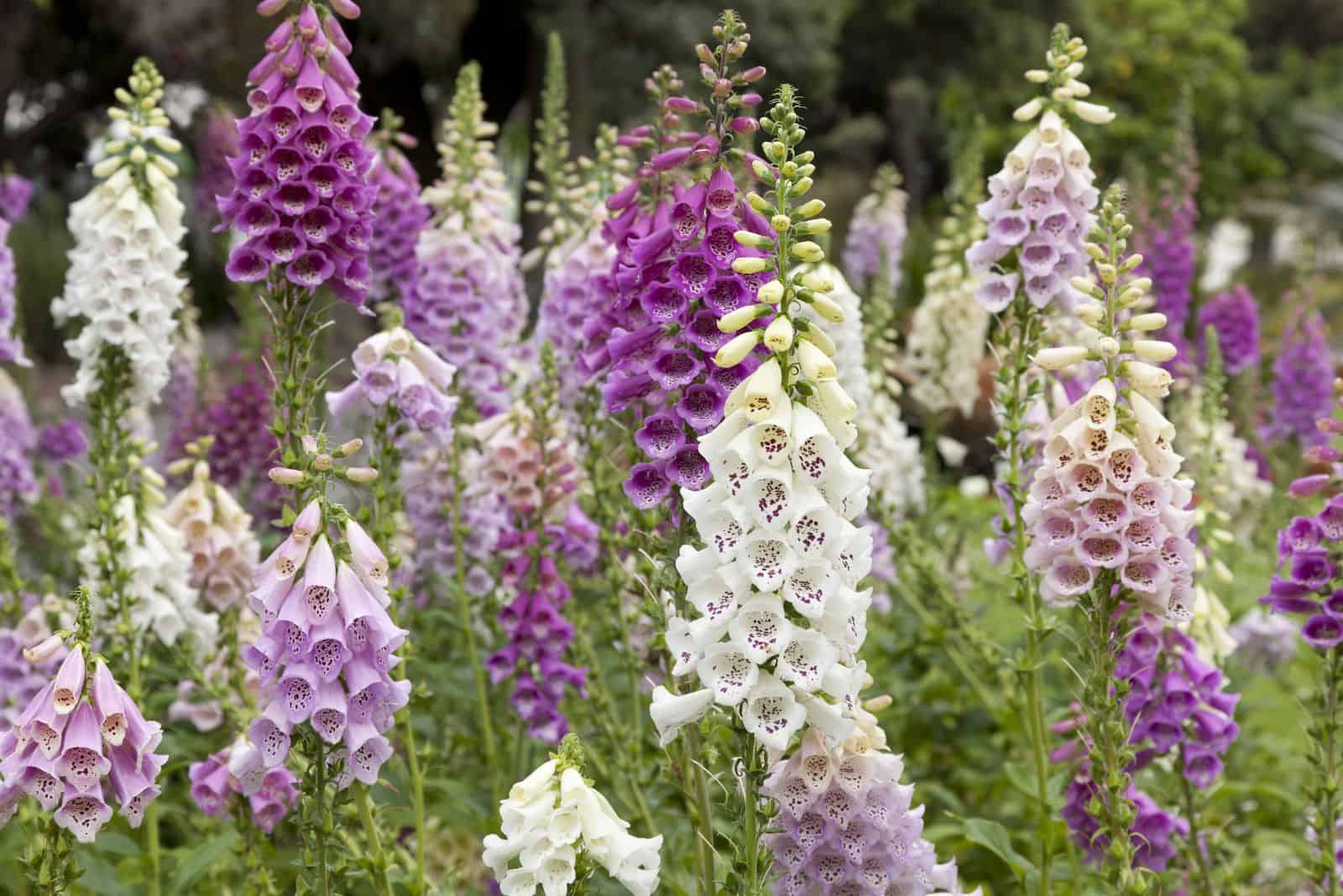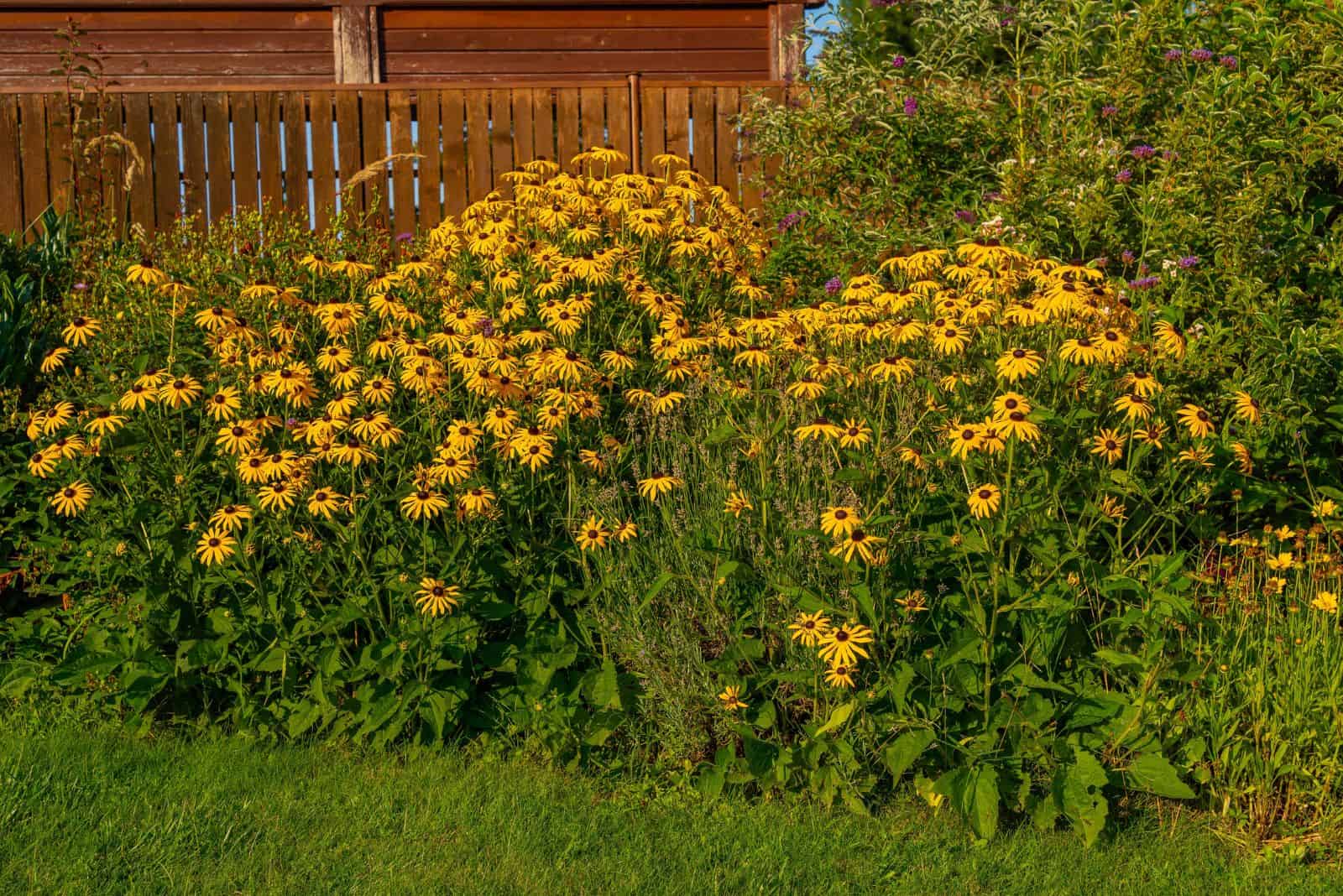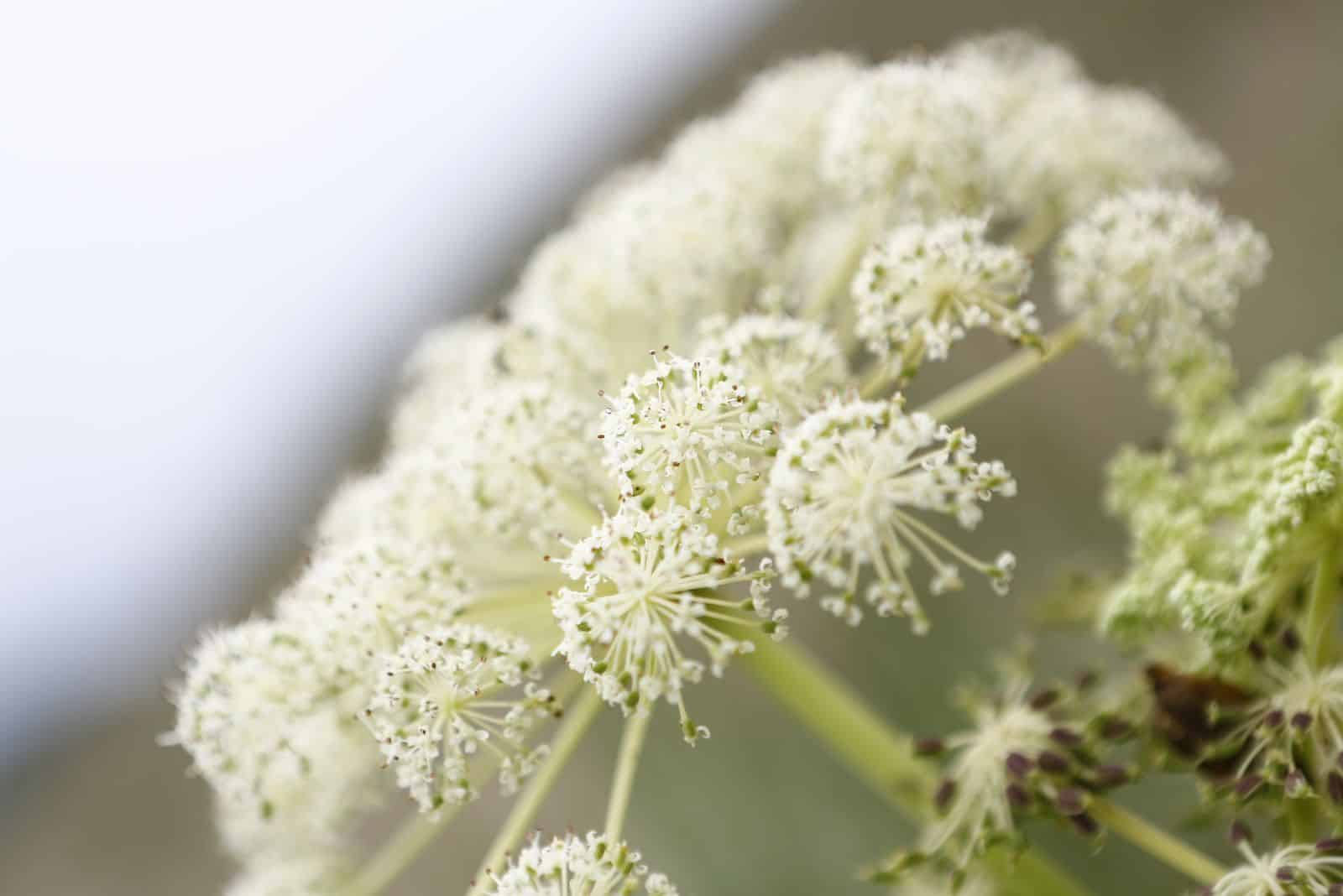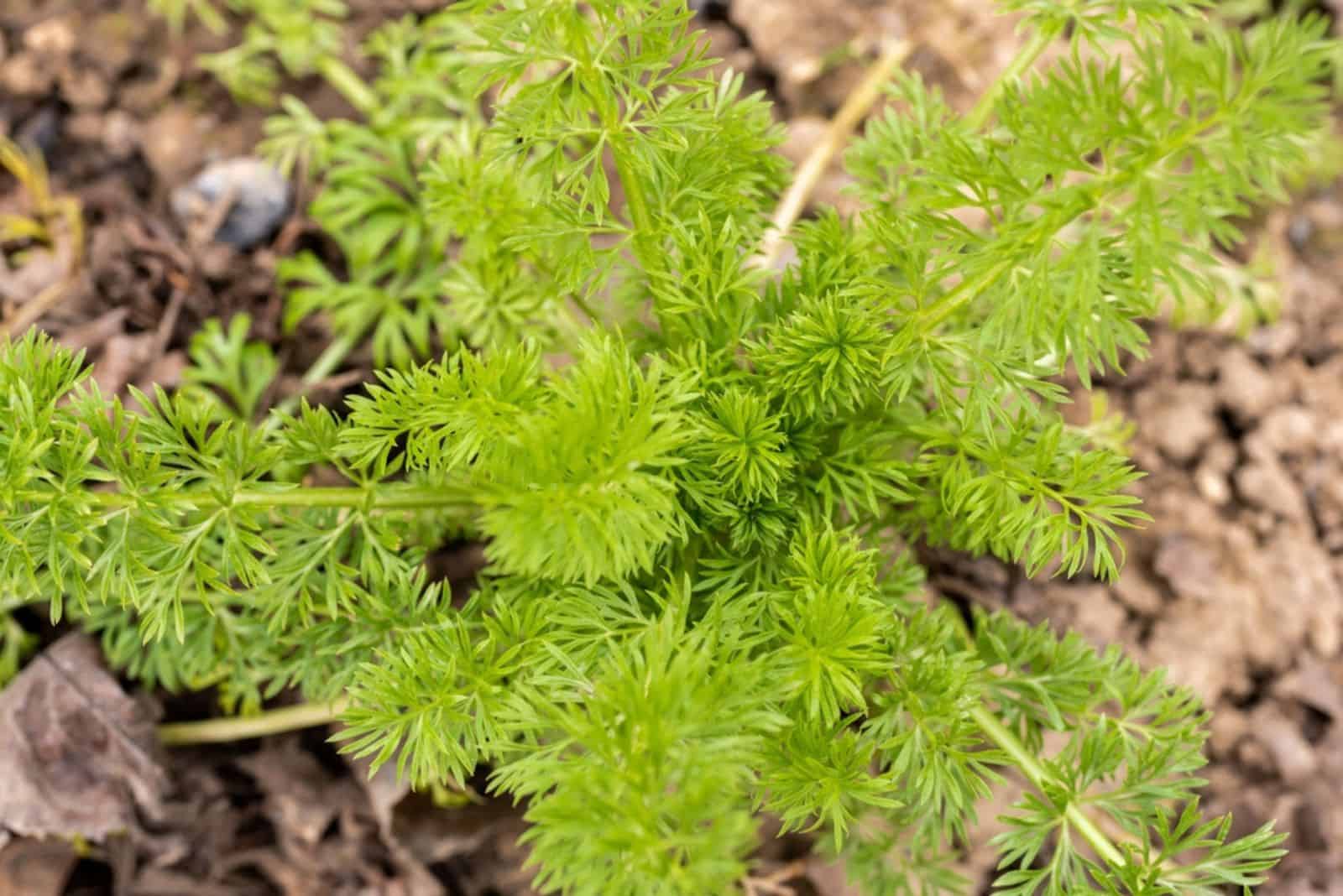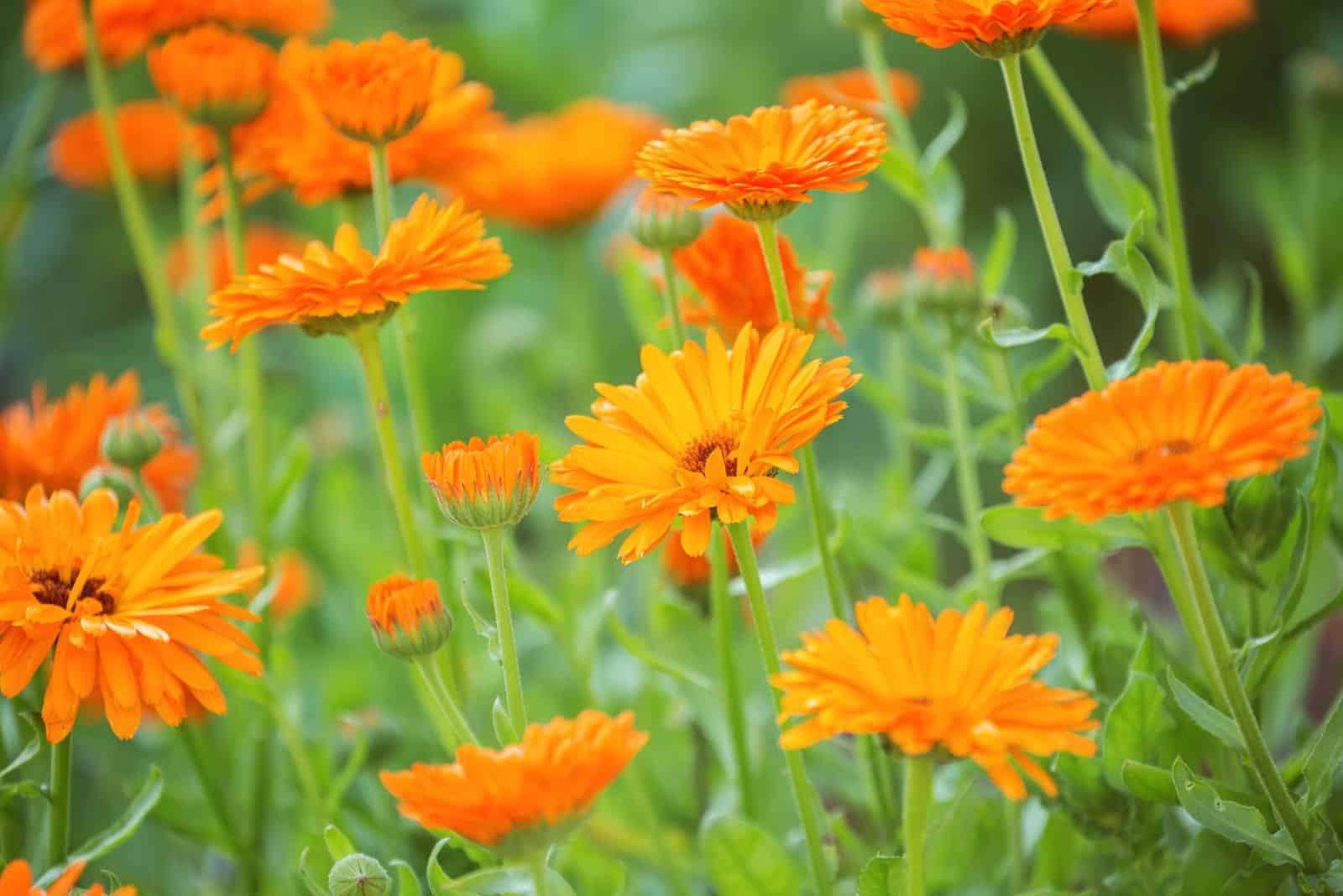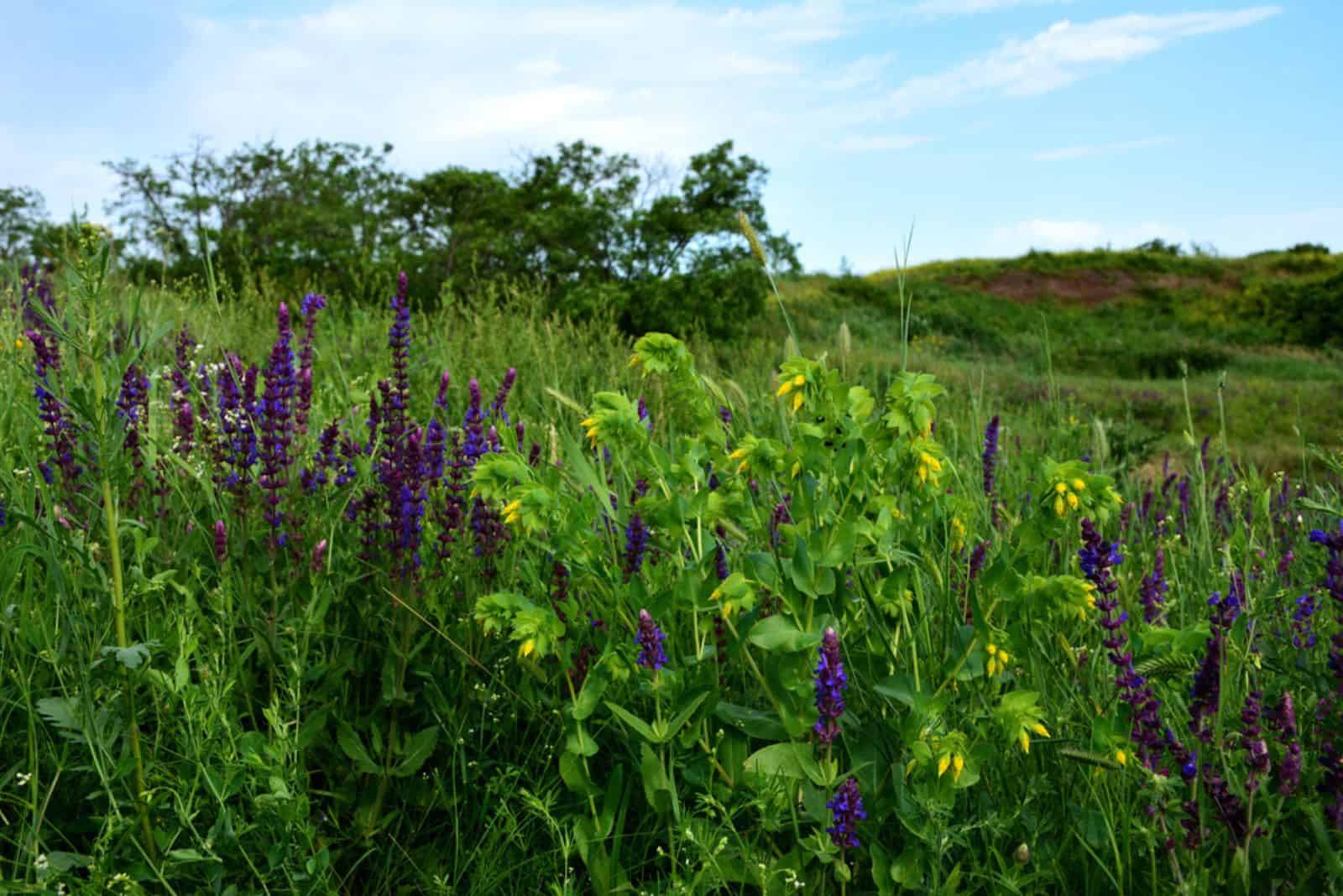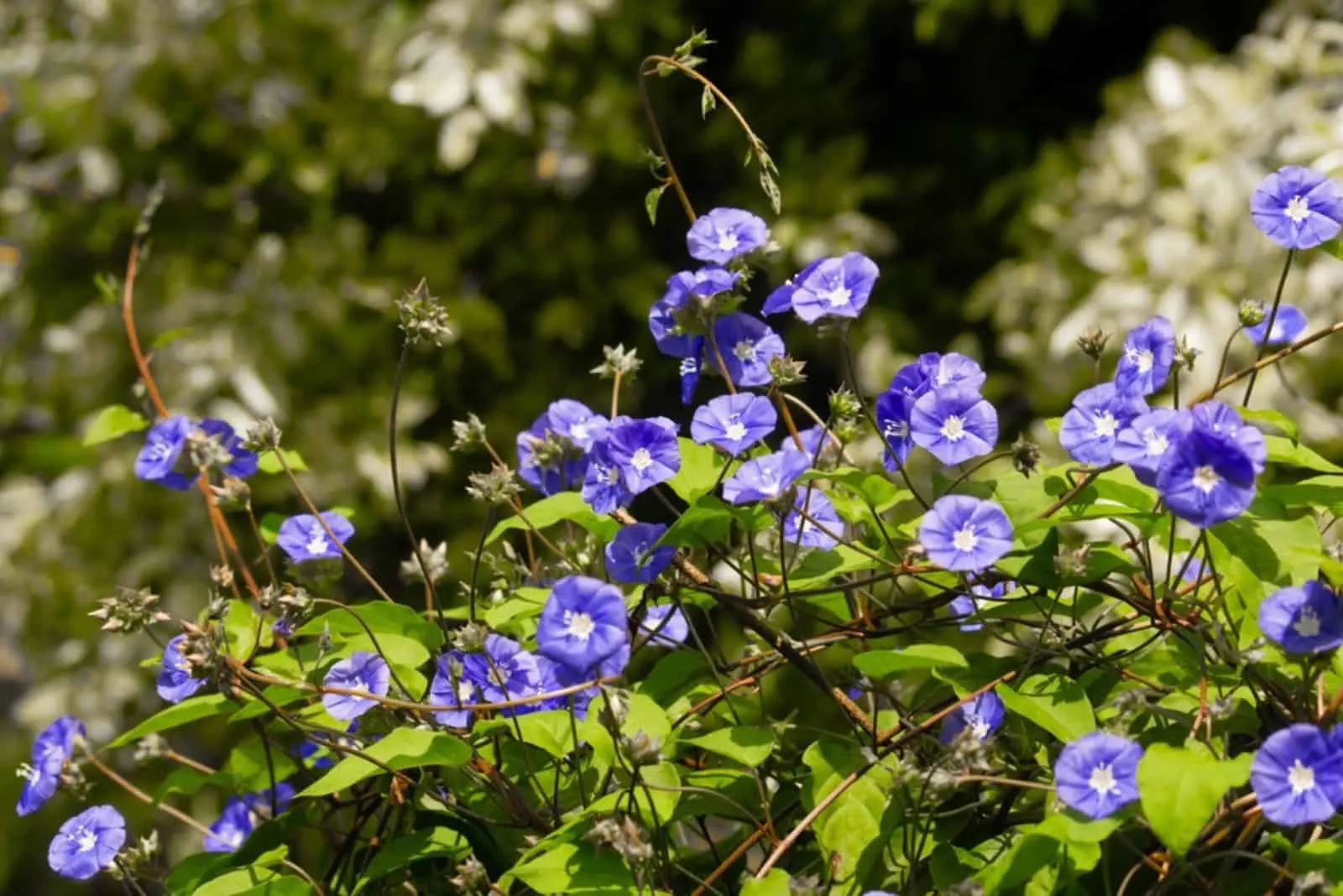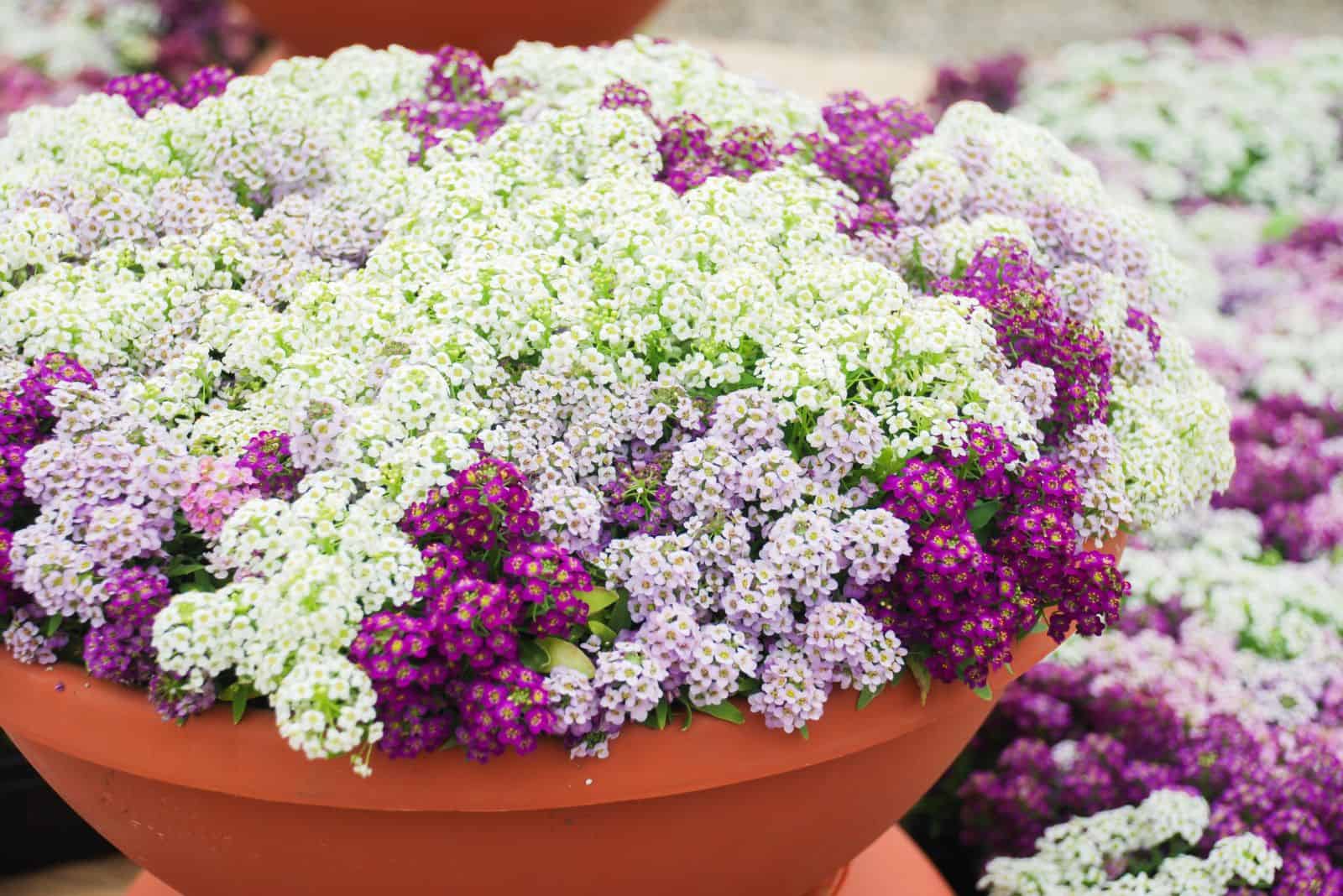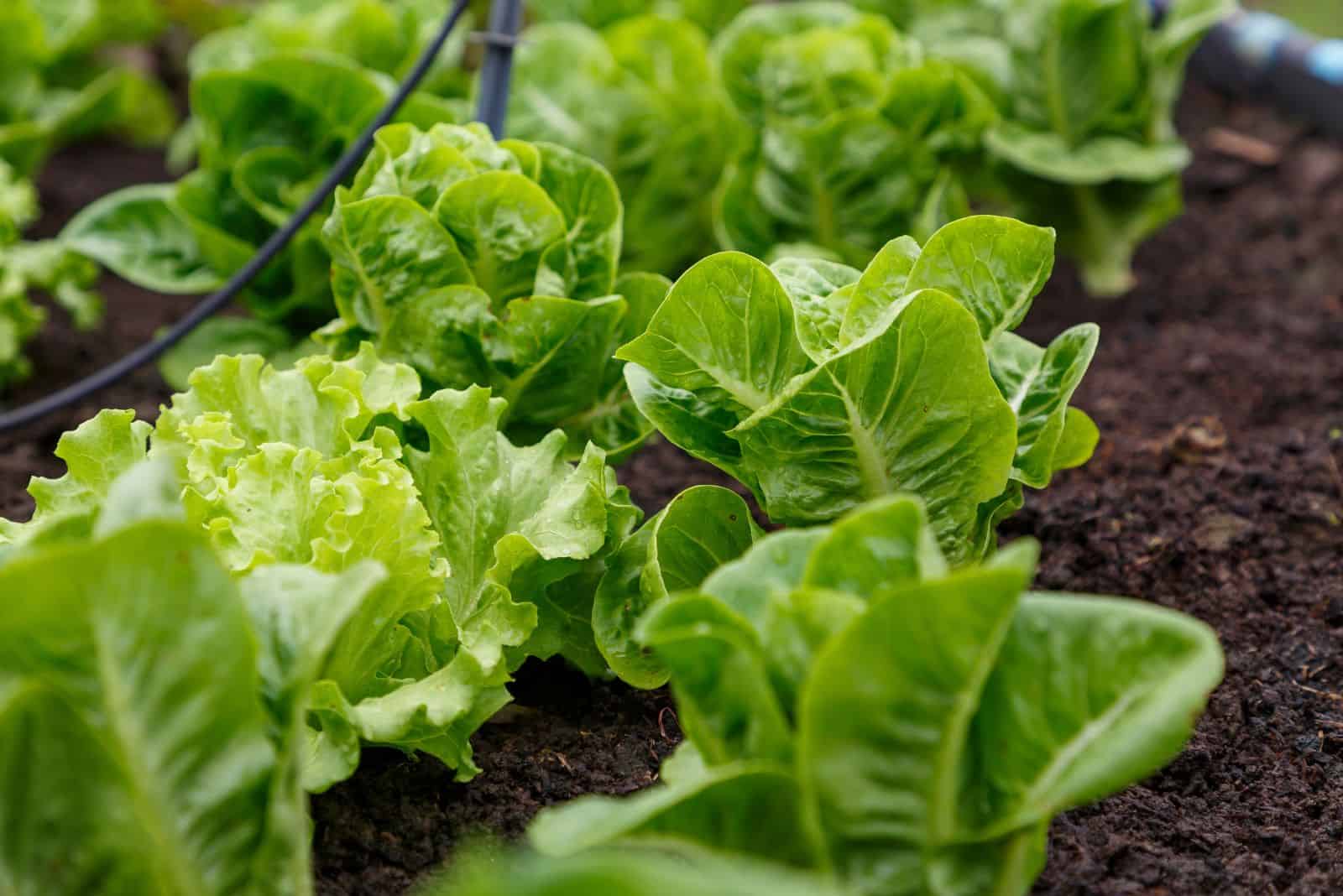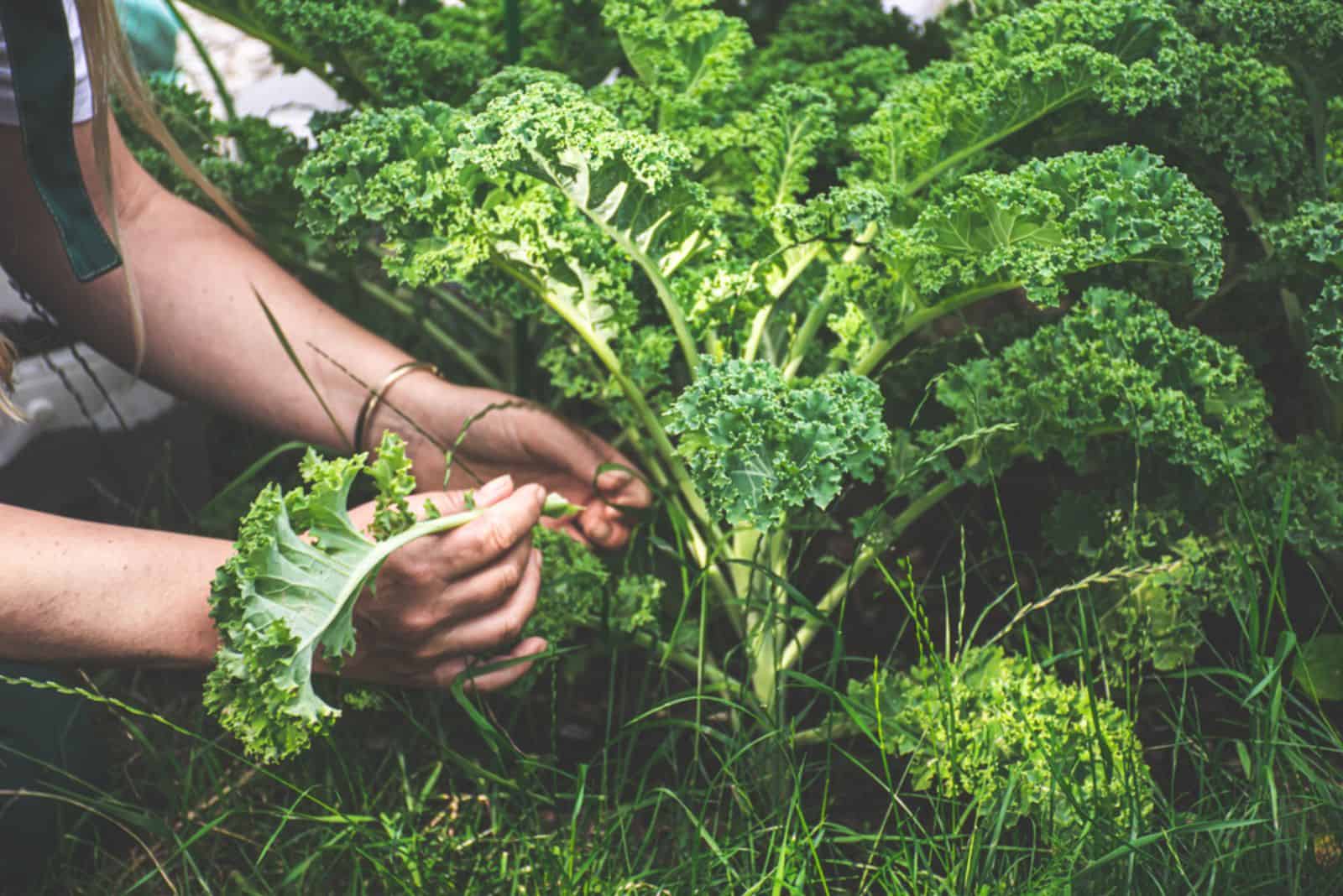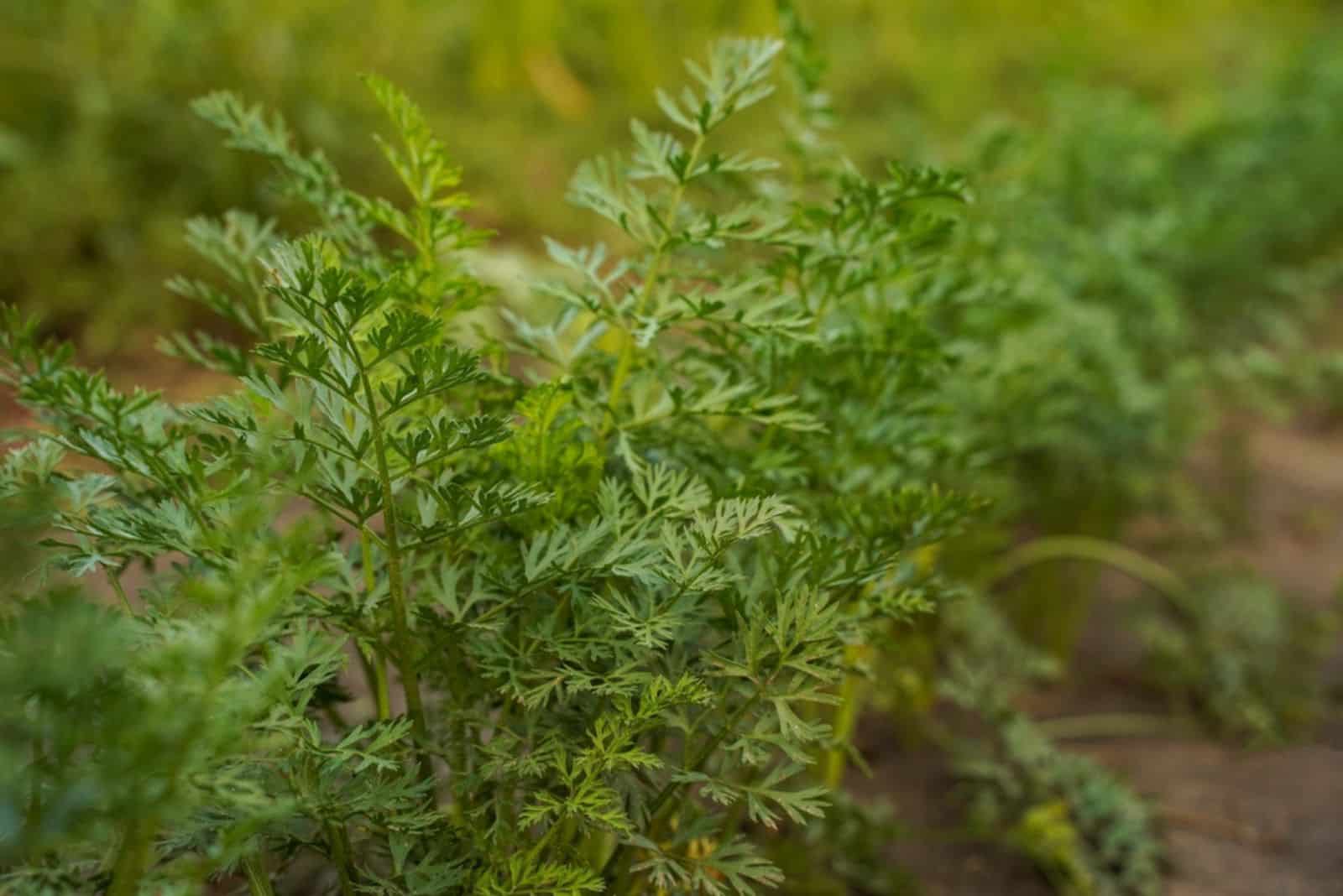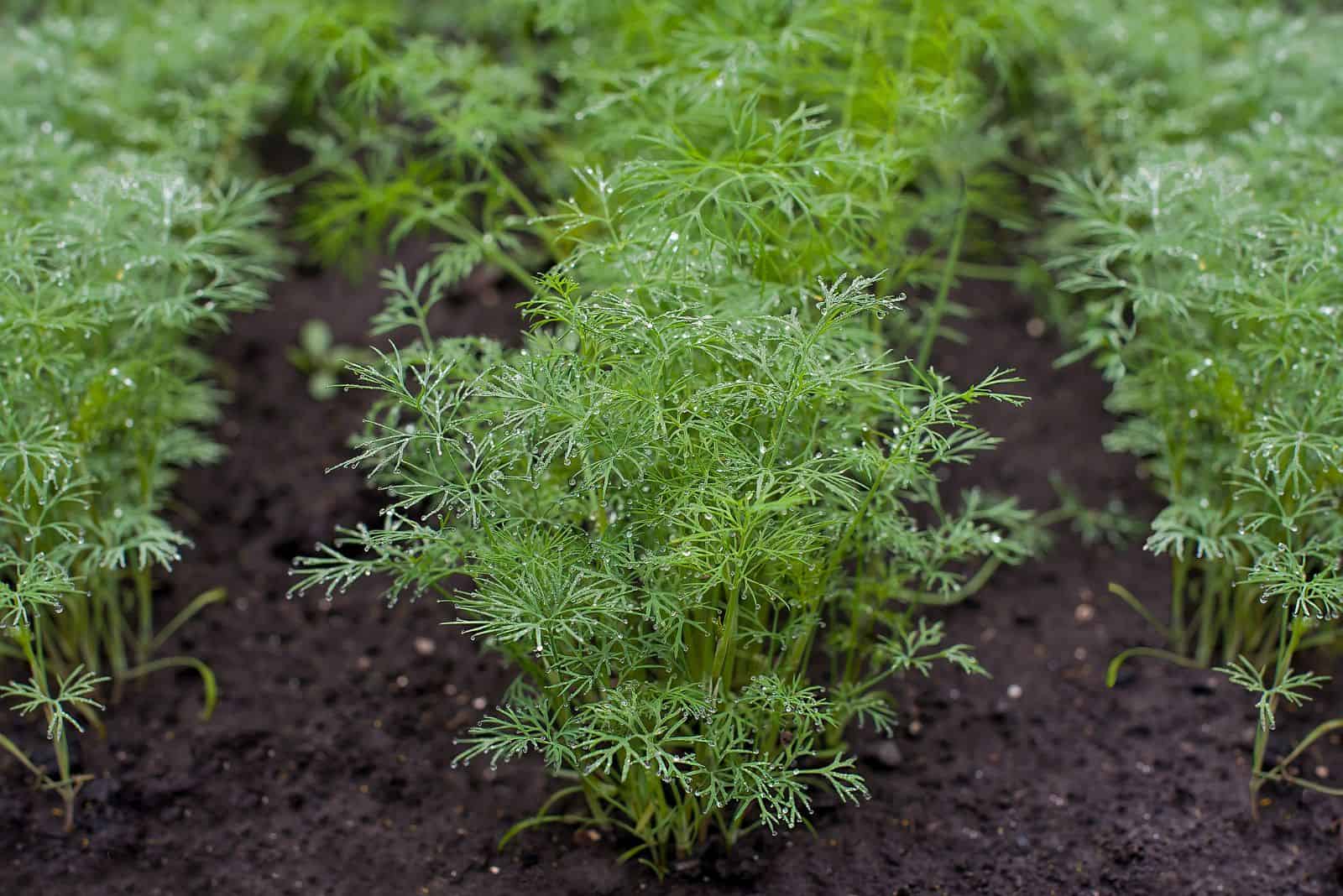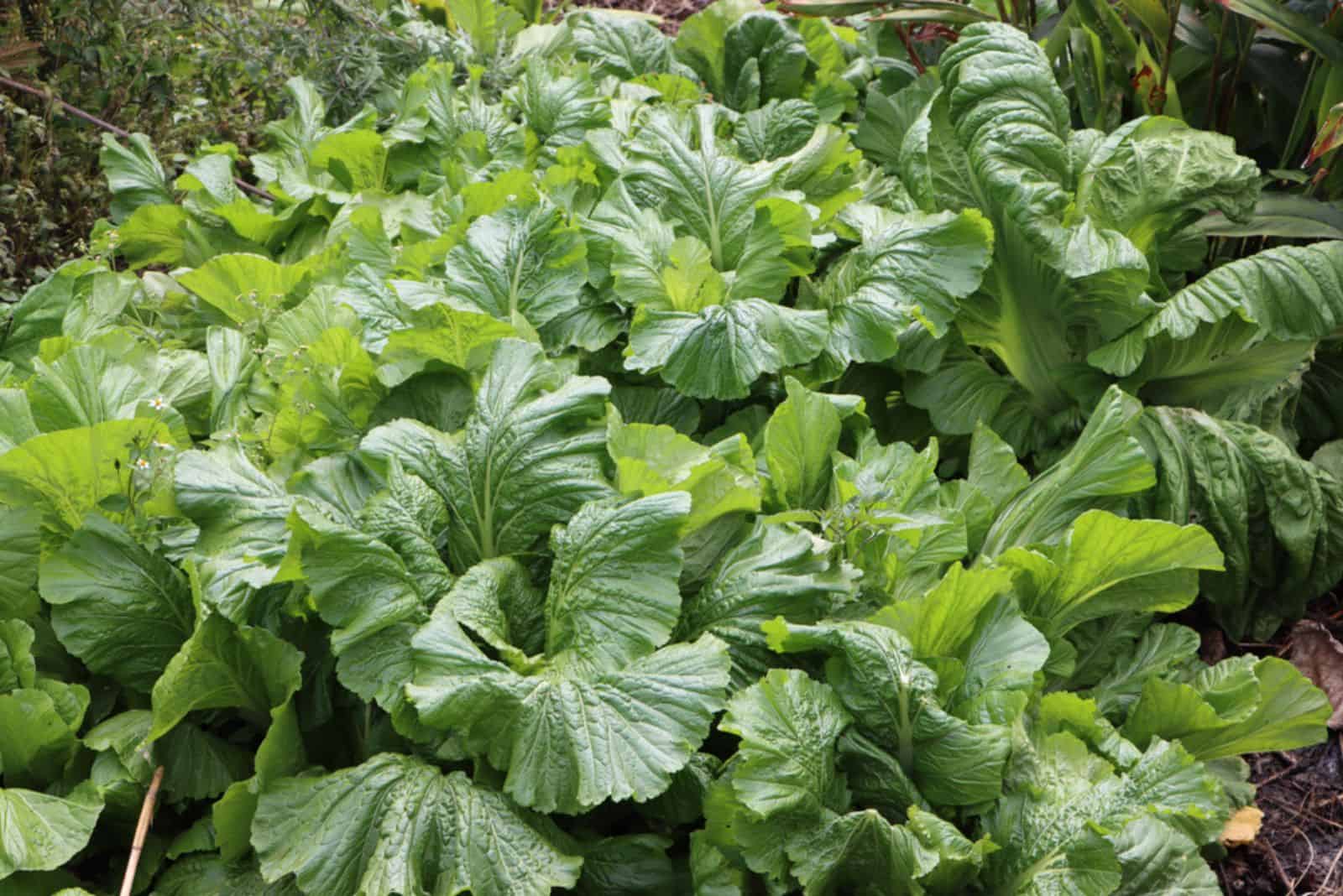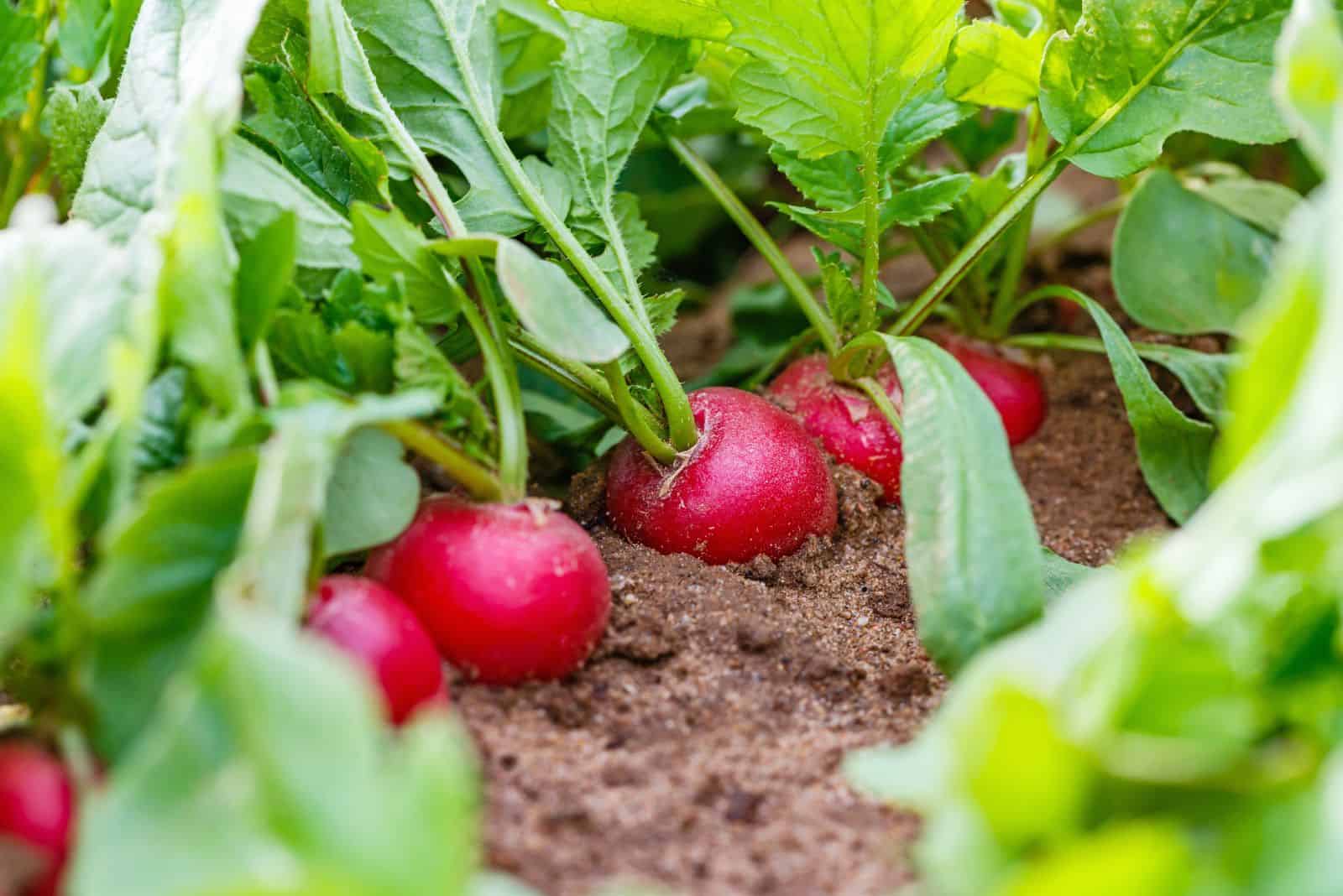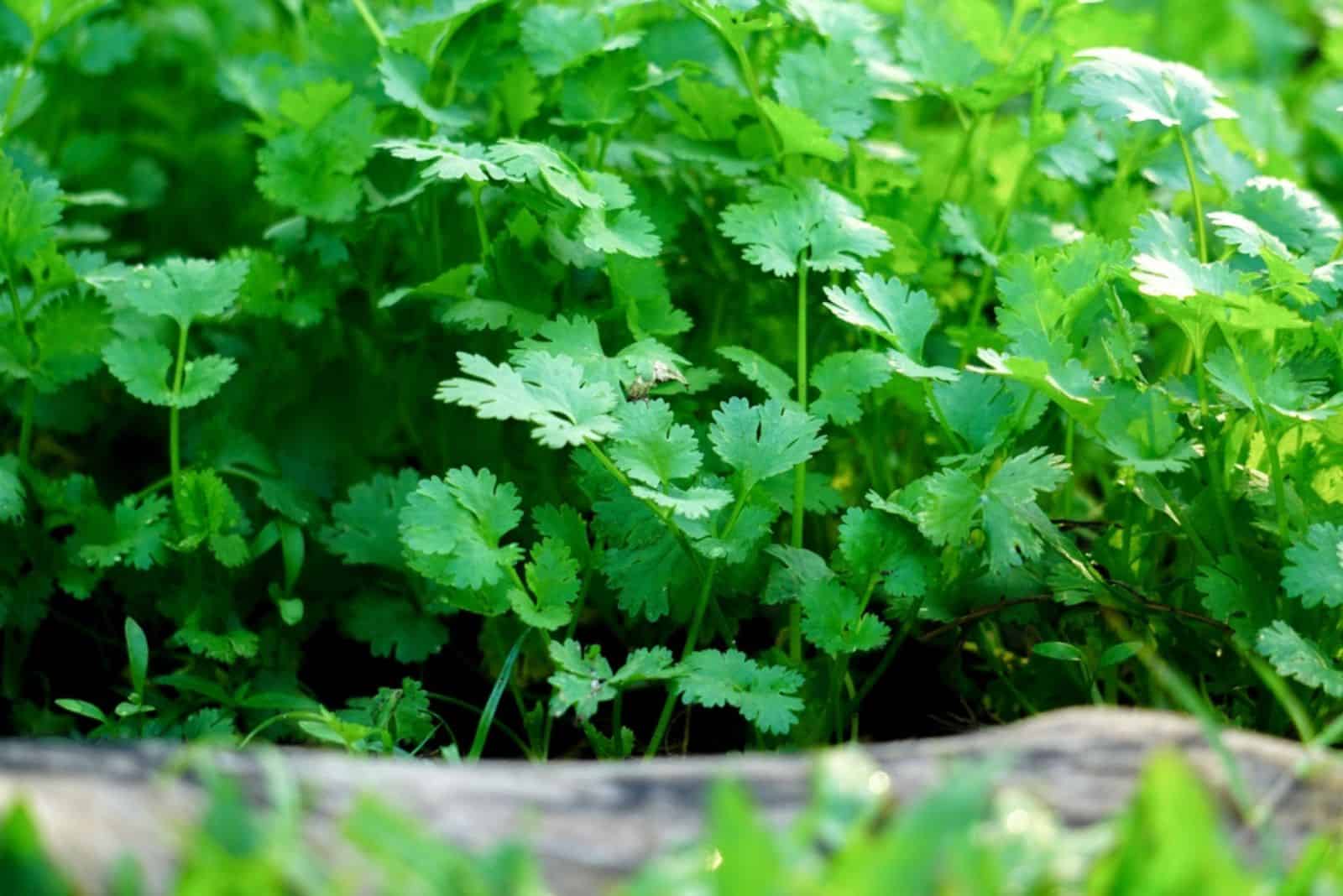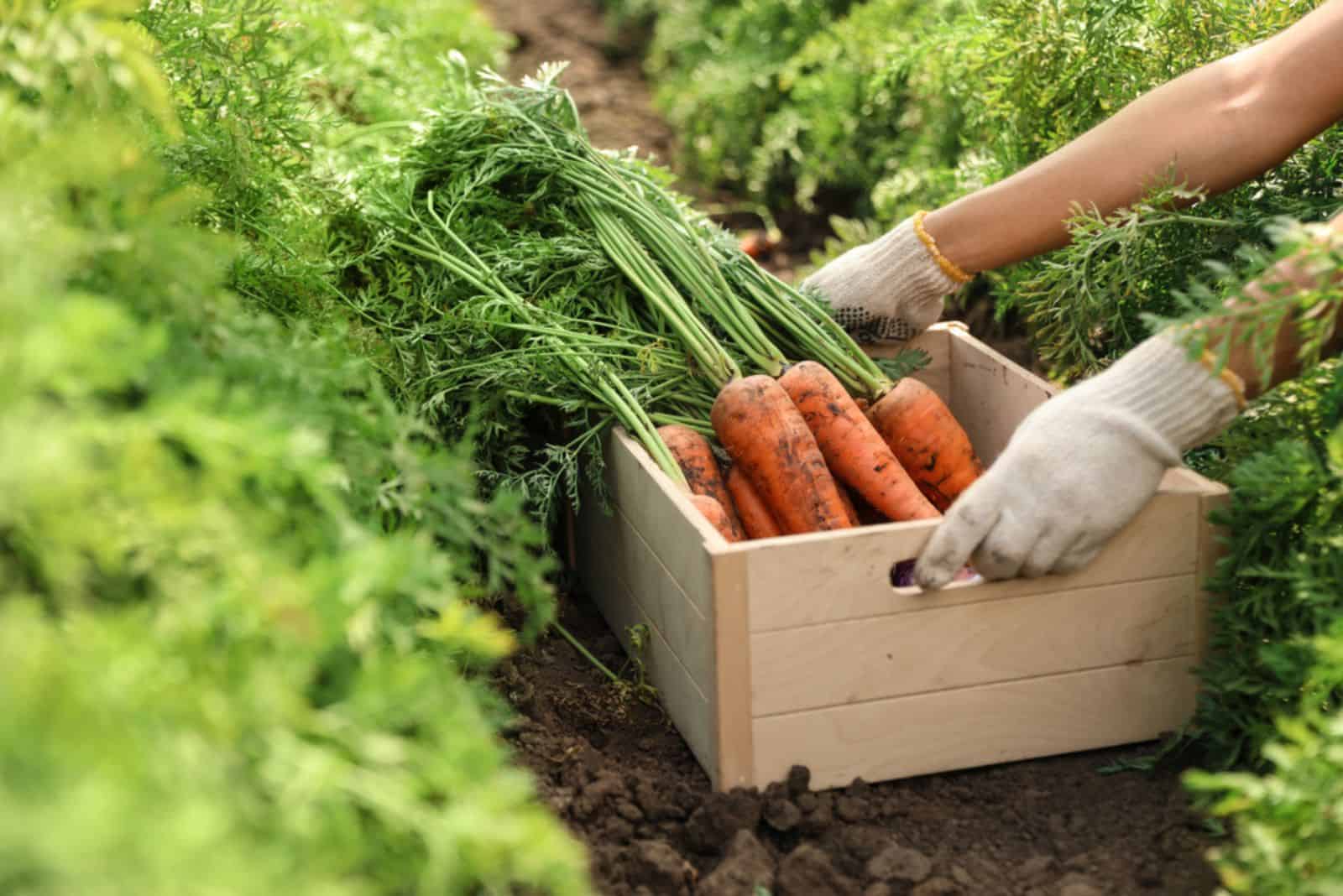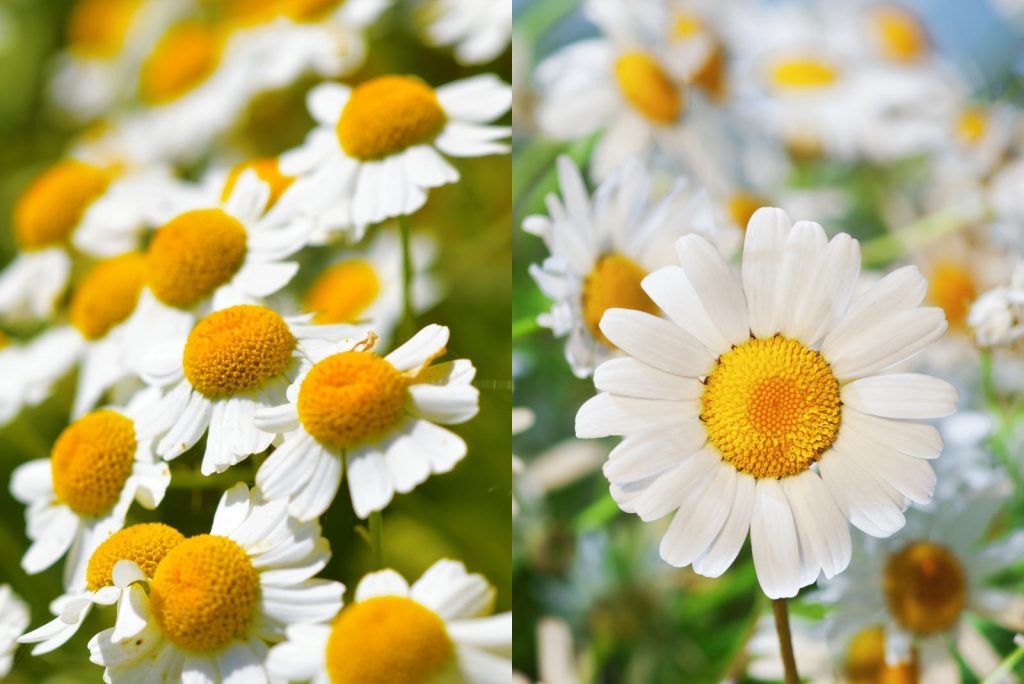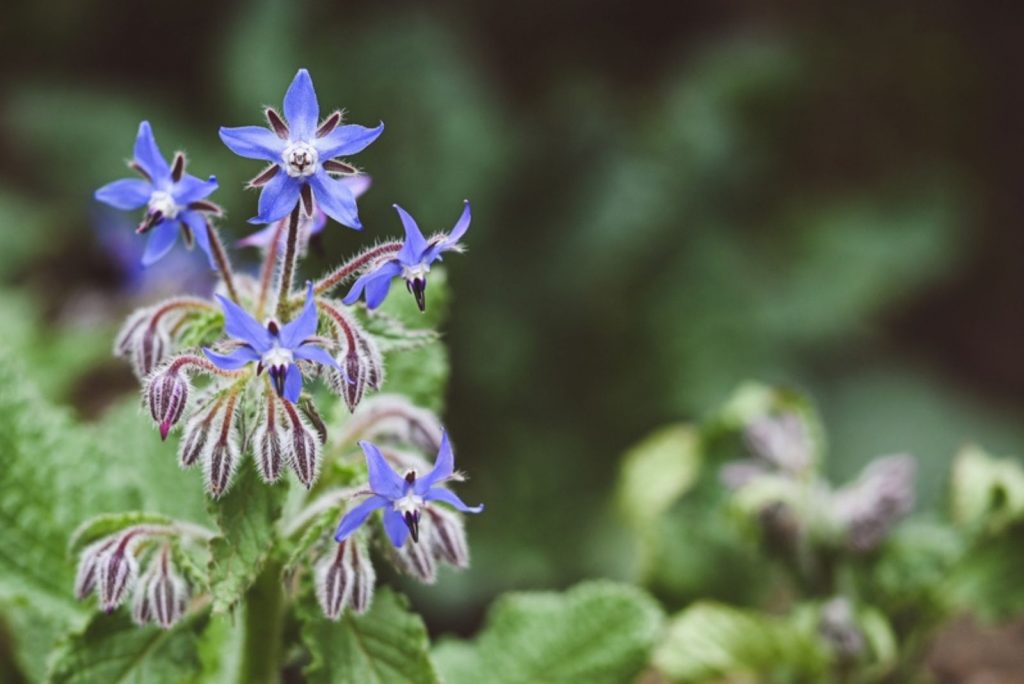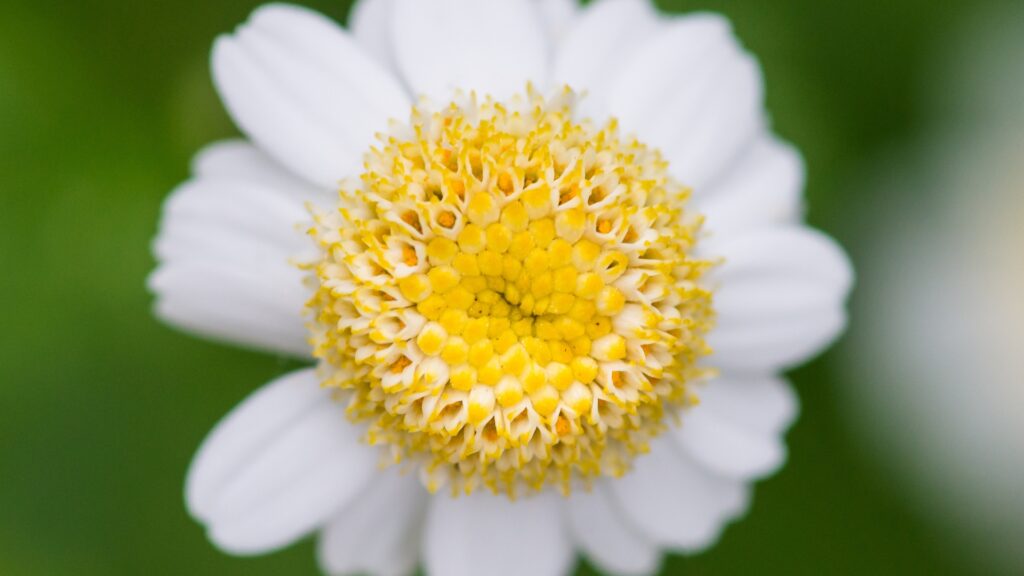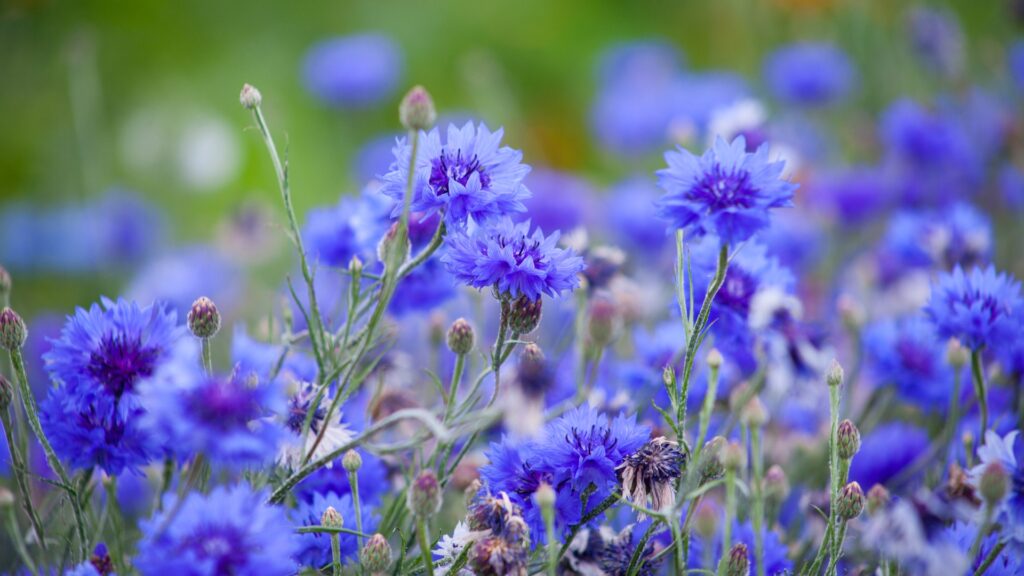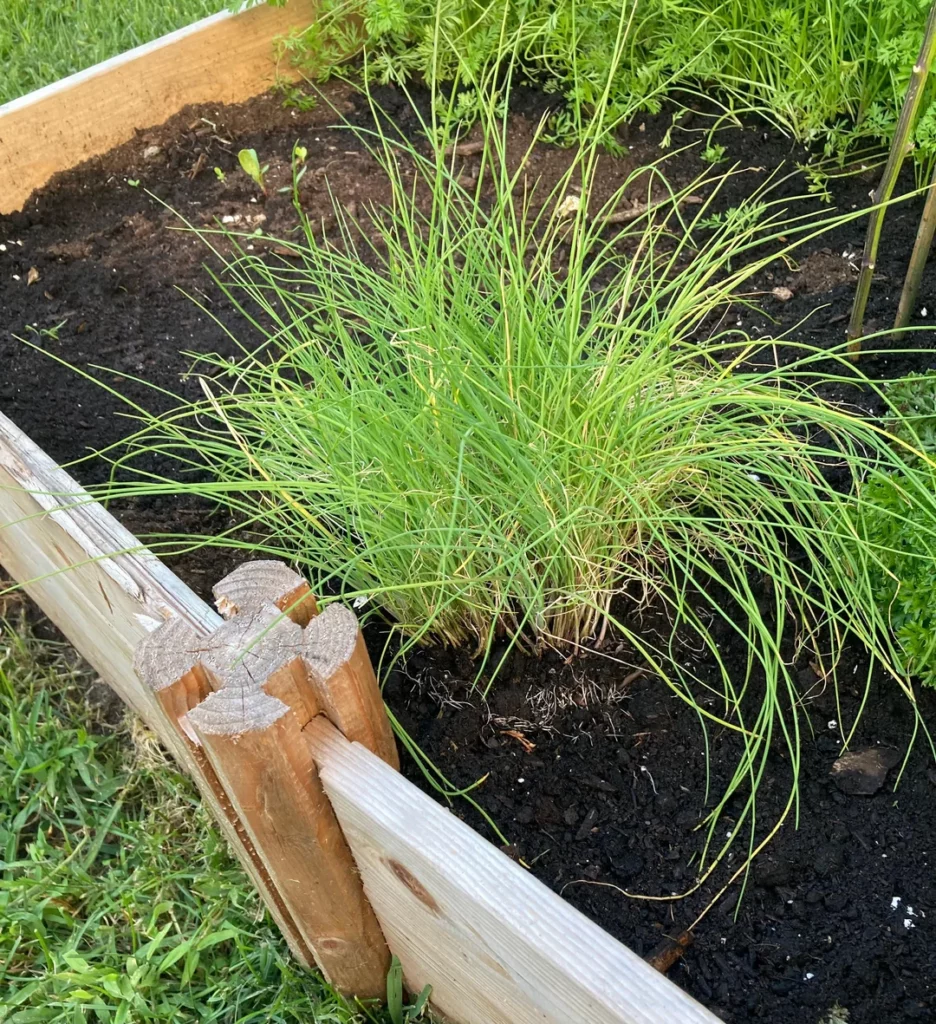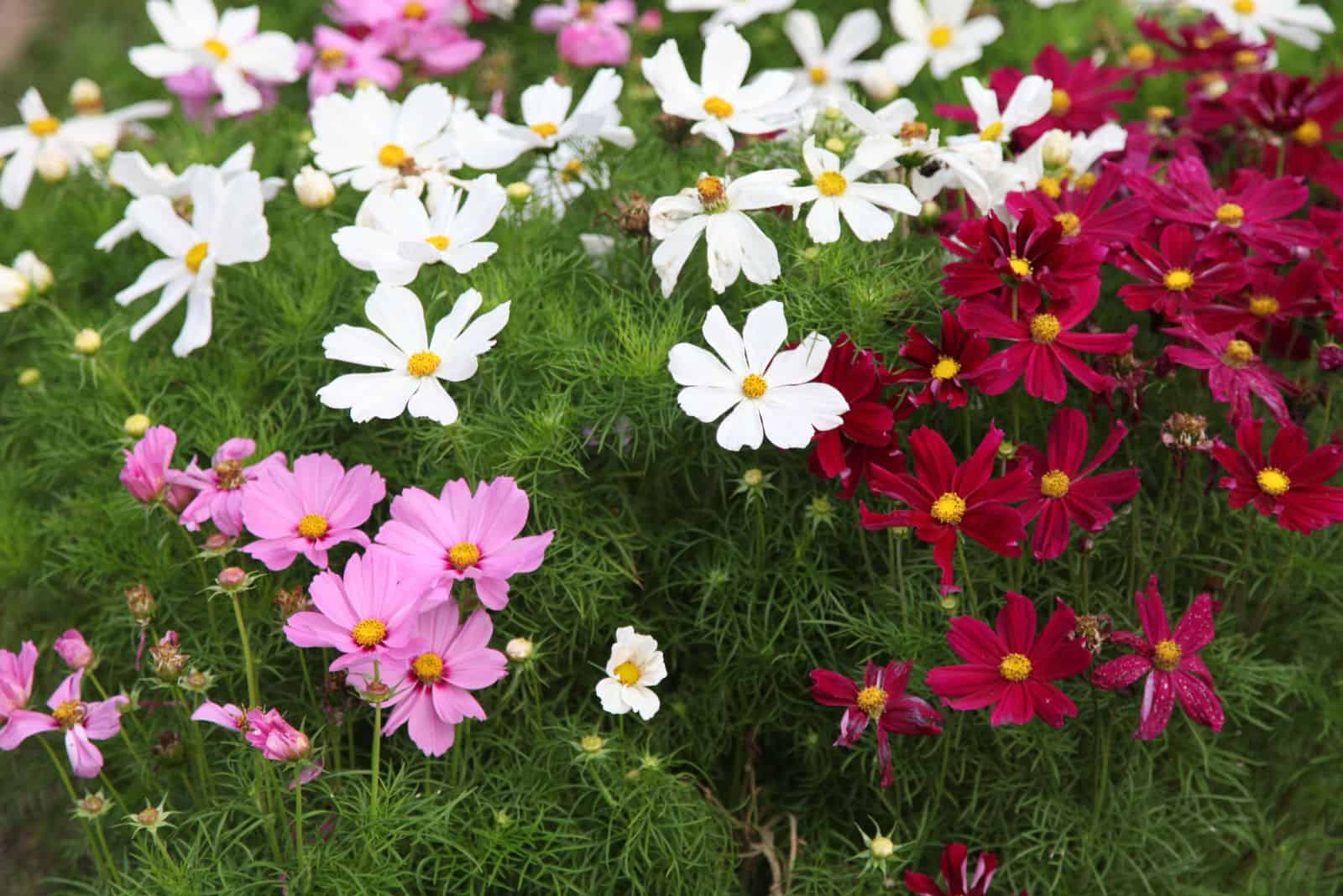Self-seeding plants are a gardener’s dream, offering an effortless way to maintain a vibrant garden year after year. These plants drop their seeds in the right conditions, allowing them to grow back without much intervention.
Whether you’re looking for low-maintenance flowers, veggies, or herbs, these plants can fill your garden with color and life season after season.
Here’s a list of 25 of the best self-seeding plants to help you create a garden that practically takes care of itself.
1. Poppy
Which flowering plants are drought-tolerant, withstand poor soils, are self-seeding, and attract pollinators? Poppies, of course!
The delicate, papery petals of poppies come in various colors and are slightly translucent, giving them an ethereal appearance. The size of field poppy plants ranges from 9 inches to 1.5 feet, with some cultivars reaching up to 4 feet tall.
You can enjoy the beautiful blossoms of poppies in late spring and early summer. Once the flowering season is over, poppy petals fall off and expose a capsule with tiny black seeds.
When the capsule is fully mature, it will explode and release seeds that will germinate as soon as the soil is disturbed in the following season.
You can successfully grow poppies if you live in USDA hardiness zones 3 to 10. Make sure to find a spot with a lot of full sun exposure.
2. Cosmos
The gorgeous daisy-like blossoms of cosmos flowers typically appear in June and last until the first frost.
Long and slender petals encircle a central disk of tubular florets. Pink, purple, white, or red, nectar-rich blooms attract a wide variety of pollinators.
If you want your cosmos to self-sow, don’t remove the spent flower heads during the blooming season.
Cosmos plants thrive in USDA zones 2-11 and need a lot of sun to grow healthy and generate an abundance of blossoms.
3. Foxglove
These stunning plants make a perfect addition to any garden, with their spiky flower stalks and colorful bell-shaped blossoms.
The majority of foxglove varieties display blossoms in late spring to early summer. Once the petals fall off, the plant will generate seed pods with plenty of tiny seeds. When the foxglove’s seed pods are mature, they release the seeds.
These plants attract bees and other pollinators, and are a perfect choice for cottage gardens and woodland landscapes.
Foxglove is suitable for cultivation in USDA zones 4-8 and requires free-draining soil rich in organic matter. I mix compost before planting and add a slow-release fertilizer to boost nutrient levels.
4. Black-eyed Susan
The hardy and low-maintenance black-eyed Susan generates lovely daisy-like blossoms with dark brown centers, starting in mid-summer through early fall. The vining varieties make excellent plants for fences.
This self-seeding perennial can grow up to 3 feet tall, attracts various pollinators to gardens, and is deer-resistant.
To promote self-seeding, allow some of the black-eyed Susan blossoms to go to seed; they’ll drop the seeds on the ground below them after the flowering season ends.
Black-eyed Susan plants thrive best in USDA zones 3-9 and flourish in full sun. From my experience, they also do well in partial shade, but you might want to boost the nutrient level by mixing well-aged manure into the soil before sowing the seeds.
5. Garden Angelica
Clusters of small white to greenish blossoms of garden angelica are arranged in umbels and generate seeds in their second year of growth.
This flowering plant can grow up to 7 feet in height and 4 feet in width, which means it will need a lot of space in your garden.
Bear in mind that garden angelica isn’t a prolific self-seeder and the seeds need to go through a process of cold stratification, i.e., they need to be exposed to low temperatures to encourage seed germination.
However, if you keep your garden angelica in full sun and moist soil (that’s never waterlogged), you can expect seeds in the second year.
These herbaceous biennial plants do best in USDA hardiness zones 5-7.
6. Love-in-a-mist
Flower beds with love-in-a-mist plants are definitely among my favorites. Their fern-like foliage and jewel-toned blossoms are simply wonderful.
Each blossom can be about an inch in diameter and develop balloon-shaped seed pods when fully mature. If you don’t remove all the spent flowers and leave some seed pods to fall on the ground, you can expect new love-in-a-mist blossoms the following year.
These plants are super easy to maintain and the love-in-a-mist will forgive you if you don’t do everything perfectly.
This hardy plant is suitable for cultivation in USDA zones 2-11. Ensure a lot of direct sunlight and make sure the water doesn’t accumulate in the soil.
7. Calendula
If you are a beginner grower and don’t know much about plants, calendula should be your first. It doesn’t need much to thrive, looks magnificent, and self-seeds.
Its cheerful daisy-like blossoms attract beneficial insects and pollinators, which means you’ll have fewer pest problems.
You can expect the flowering season to begin in mid-summer and last until the first frost. To encourage your calendula to produce more golden blossoms, deadhead the spent flowers regularly.
And if you want it to self-sow, simply leave the flowers to generate seed pods and release the seeds.
You can successfully grow calendula if you live in USDA zones 2-11. Plant it in full sun or partial shade and enjoy the view.
8. Honeywort
I commonly refer to honeywort as the King of unusual plants. Its egg-shaped bluish-green foliage, and purple showy blossoms make any garden stand out.
One of the best things about honeywort is that its flowers last a long time and attract hummingbirds and bees.
At the end of the flowering season, honeywort blossoms will begin to produce seeds. If you want to save the seeds for the next season, wait until the pods turn brown and dry out.
You can grow honeywort if you live in zones 2-11 and it will generate an abundance of gorgeous blossoms as long as it has enough full sun.
9. Morning Glory
The breathtaking trumpet-shaped blossoms of the morning glory plant come in various colors, such as purple, pink, and white. It’s one of the most popular plants for all garden designs.
This is an annual plant, which means it will die back after it generates flowers, but if you don’t remove all the flower heads, you can get an abundance of blossoms the following season. As the years go by, you can expect more and more blossoms.
However, there’s a catch with morning glory. If you let the seeds spread and don’t control the growth, its vines can take over your garden. Once the seeds germinate and the seedlings emerge, pull them out and relocate them or do my favorite thing, which is giving some to your friends!
USDA zones 3 through 11 are all suitable for morning glory and it likes being in full sun all the time.
10. Sweet Alyssum
Sweet alyssum is a fragrant and delicate plant with a low-growing habit. It’s renowned for its tiny colorful flowers. Bees and other pollinators adore them!
This plant generates an abundance of flowers that usually completely cover the oval-shaped foliage.
One of the best features of the sweet alyssum plant is that each seed pod develops two seeds, so the number of blossoms will double the following season.
These plants do best in zones 5 through 9 and won’t mind if they’re planted in a spot with partial shade.
Self-seeding Edibles
Now let’s take a look at which edible plants will come back next year!
11. Lettuce
Lettuce is definitely one of the most popular leafy greens out there. You can encourage new growth by removing some of the leaves as the plant develops further.
This veggie thrives in cooler temperatures and as soon as the temperatures rise, it will start bolting. It’s actually a good thing to let your lettuce produce flowers because they’ll generate seed pods, so you won’t need to plant your lettuce next year.
You can grow lettuce in zones 2-11, just pay attention to temperature tolerance when selecting a cultivar.
12. Kale
Kale is a versatile veggie that has many health benefits. You can harvest its delicious leaves at any stage. For me, baby greens taste best!
This is an annual plant, which means you’ll need to wait until the second year of growth for your kale to generate flower stalks. They’ll give rise to long thin seed pods that will release the seeds when the flowering season is over.
The lowest temperature the kale plant can withstand is 5 degrees Fahrenheit, which means you can cultivate it if you live in USDA zones 7 and above.
13. Parsley
You’re probably surprised to see parsley on this list. Growers typically plant their parsley every year, but these are biennial plants you can use as an advantage.
Plant your parsley seeds and wait until next season when the plant generates flower stalks. Allow them to flower and let the seeds fall on the ground.
Since the seeds can distribute uncontrollably, you’ll most likely need to do some thinning and transplanting so that they have enough space.
14. Dill
Dill will make your garden prettier and scented, and you can eat the dill weed (dill leaves) or use their seeds as a spice.
Since this is a self-seeding plant, you can allow your dill to produce flowers and let the seeds drop on the ground.
Don’t worry, dill is a prolific seeder so you’ll have enough seeds for both spice and a lot of new plants the next year.
Dill does best when cultivated in USDA zones 2-9 and needs full sun for healthy development.
15. Mustard Greens
Mustard greens are cool-weather crops and typically grown as annuals. However, you can get your mustard greens to develop seeds if you provide them with the right conditions.
Planting mustard greens in free-draining soils and regularly watering them will ensure healthy growth and help the plant enter the flowering stage.
When the temperatures drop significantly, the seeds of your mustard greens will go dormant and wake up as soon as spring arrives.
16. Arugula
I never use the name arugula because its nickname, Rocket, fits better. These annuals are ready for harvest when summer begins.
As soon as the temperatures rise, your arugula will start bolting. If you want it to self-seed, simply leave the flowers and let nature take care of it.
These delicious leafy greens do best in USDA zones 5-9.
17. Radishes
This is one of the tastiest root veggies you can grow in your garden. Many people are surprised when they find out that radishes can self-seed.
Hot summer temperatures will affect the growth of your radishes, but this can be turned in your favor if you let the plant produce the flowers and germinate next season.
Never allow water to accumulate in the soil where you plant your radishes because this is a root-veggie that can quickly rot.
18. Cilantro
Cilantro doesn’t like high temperatures, so you need to plant it early in the season. Deadheading can promote the production of new cilantro leaves.
However, if you don’t deadhead all the flowers, they’ll start developing seed pods when temperatures rise.
Sometimes, new cilantro seedlings can emerge in the fall if you leave the plant to self-seed in summer.
19. Carrots
Carrots were the first plants I tested self-seeding on. I left a couple of carrots in the ground and let them overwinter. When soil temperatures rose, my carrots showed new growth and developed flowers later in the season. Test passed!
Although some growers claim that this type of carrot doesn’t taste the same, I honestly didn’t notice any differences.
20. Chamomile
Chamomile is the perfect self-seeding herb for a charming and fragrant garden. With its delicate daisy-like flowers and calming scent, this plant isn’t just beautiful—it’s useful, too! Chamomile tea is a favorite for relaxation, and growing your own fresh supply makes it even better.
As a self-seeding annual or short-lived perennial, chamomile drops its seeds after flowering, ensuring new plants appear the following season.
Just give it full sun and well-draining soil, and it will reward you with fresh blooms year after year.
21. Borage
Borage is a true garden superstar, boasting striking star-shaped blue flowers that bees and butterflies can’t resist. This edible herb is also packed with benefits—its leaves and flowers are used in salads, while its deep roots improve soil structure.
This resilient plant easily self-seeds, meaning it will return every year without any effort on your part.
Borage thrives in full sun and well-drained soil, making it a must-have for low-maintenance, pollinator-friendly gardens.
22. Feverfew
With its dainty white flowers and bright yellow centers, feverfew looks like a mini daisy—but it packs a punch in both beauty and traditional herbal use. This hardy plant blooms from early summer through fall and is known for naturally repelling pests like aphids and mosquitoes.
Once established, feverfew self-seeds freely, so you’ll find little volunteers popping up all around your garden beds the following spring. Just leave the flower heads to mature and drop naturally.
Feverfew thrives in USDA zones 5-9, enjoying full sun to partial shade and average, well-draining soil. It’s a low-maintenance charmer with plenty of personality.
23. Cornflower (Bachelor’s Button)
The classic blue blossoms of cornflower—also known as bachelor’s button—bring a nostalgic cottage garden charm. These cheerful annuals bloom from late spring into summer and are adored by bees, butterflies, and beneficial insects.
As long as you leave a few spent blooms on the plant to dry and drop, you’ll have a fresh patch of cornflowers returning each year. They’re quite generous when it comes to reseeding, so be ready to thin out seedlings or spread the love to other parts of your garden.
Cornflowers do best in USDA zones 2-11, with full sun and soil that’s not too rich. A bit of tough love actually encourages better blooms!
24. Chives
This easy-going herb adds flavor to your dishes and a pop of purple color to your garden. Hardy perennials, chives come back year after year with minimal effort.
Once they flower, the seeds naturally sow themselves in the surrounding soil, bringing new plants without any extra work.
Chives thrive in full sun and well-drained soil, growing best in USDA zones 3-9. Plus, they attract bees and butterflies, making them a great companion plant in any garden.
25. Sunflower
Known for their bold yellow petals and towering stems, sunflowers are also masters of self-seeding. After blooming, the mature seeds fall to the ground, ready to sprout next season.
They love full sun and well-drained soil, making them perfect for bright spots in your garden.
Not only do they attract pollinators, but their seeds also feed birds, making them beneficial to wildlife. Plant sunflowers in USDA zones 2-11 and enjoy their beauty year after year.
5 Tips For Creating And Maintaining A Self-sowing Garden
Self-seeding plants are undoubtedly a wise choice for your garden because they can save you money, time, and a lot of work.
However, there are a couple of things to consider if you want to start a self-sowing garden. Here are 5 tips to help you have the best self-sowing garden ever!
1. Choose the right plants: Make sure the plants you intend to grow in this garden are really self-seeding (our list can help you with that). I don’t recommend growing hybrids in this type of garden because the plants you get the next year might not be the same as the parent plants.
2. Allow the plants to produce flowers: There’s one simple rule when it comes to a self-sowing garden – do not deadhead! Only the plants you allow to develop flowers will successfully turn into new plants next year.
3. Don’t de-weed in spring: Growers typically de-weed in spring, but if you allowed your plants to self-sow the previous year, it may be hard to distinguish them between weeds. Wait until the seedlings emerge and generate true leaves before you start de-weeding.
4. Plant in groups: You can arrange your self-seeding plants in groups to allow cross-pollination and improve the chances of seed development.
5. Thin the seedlings: Some self-seeding plants need a lot of space to grow, so start thinning them when the seedlings emerge.

